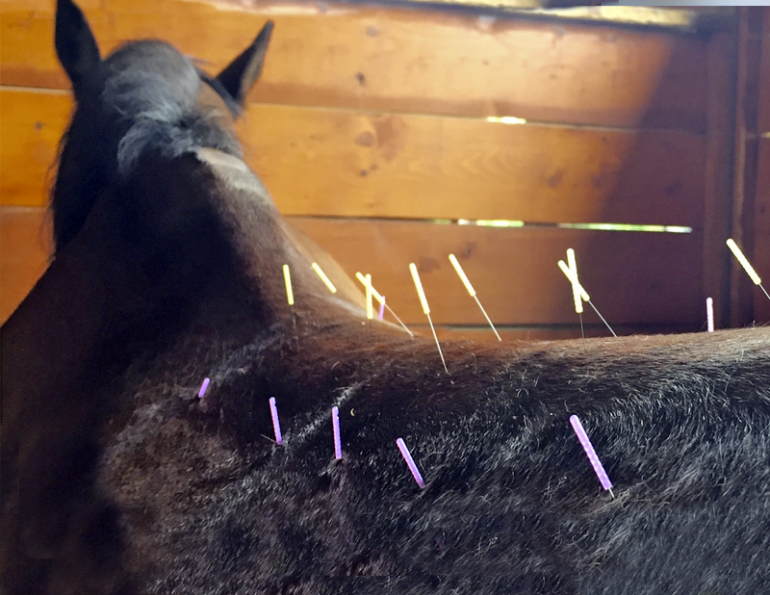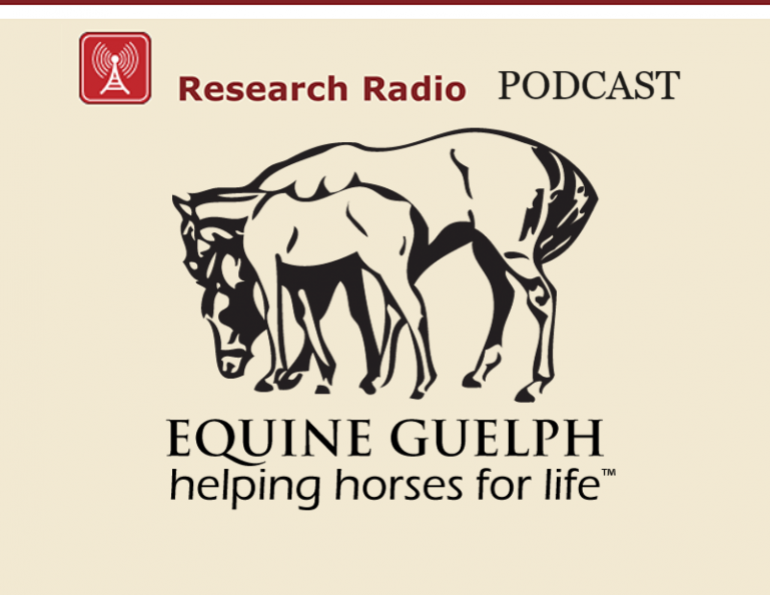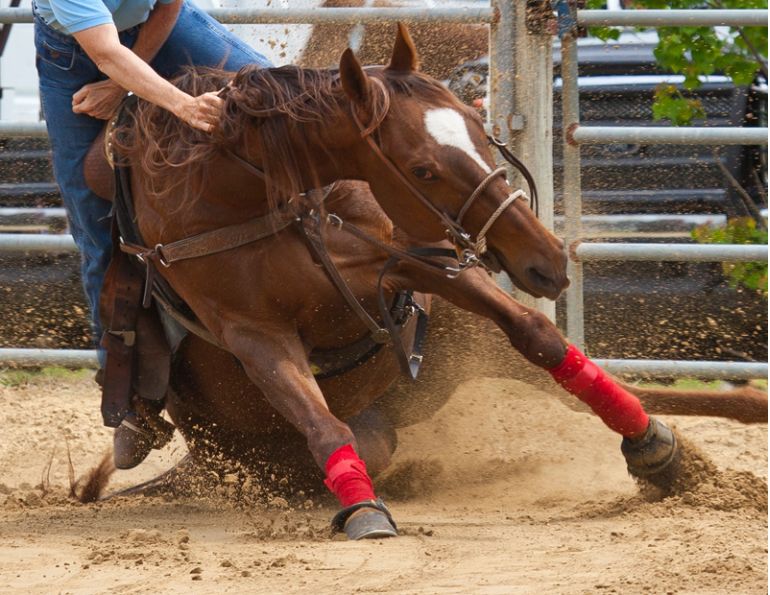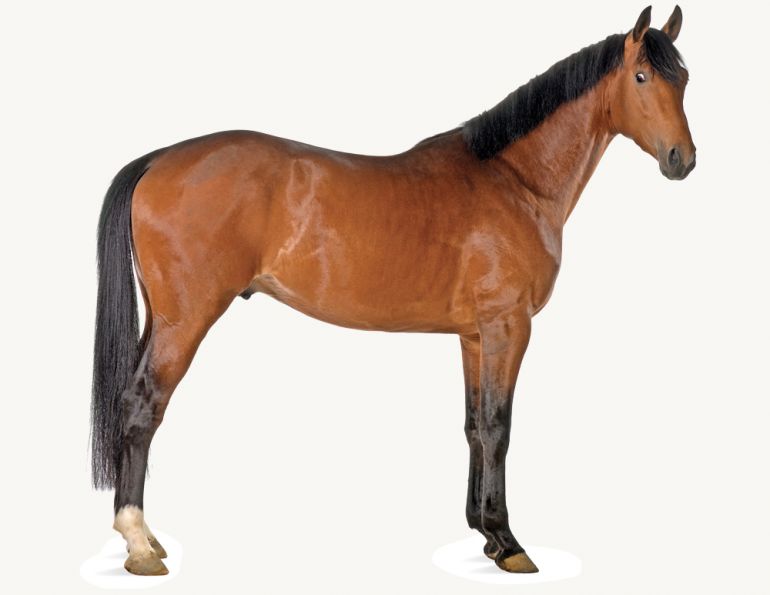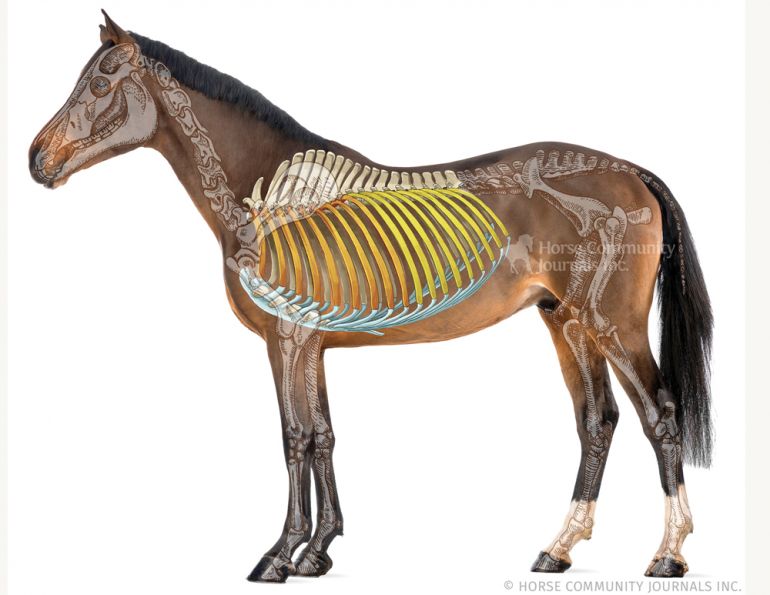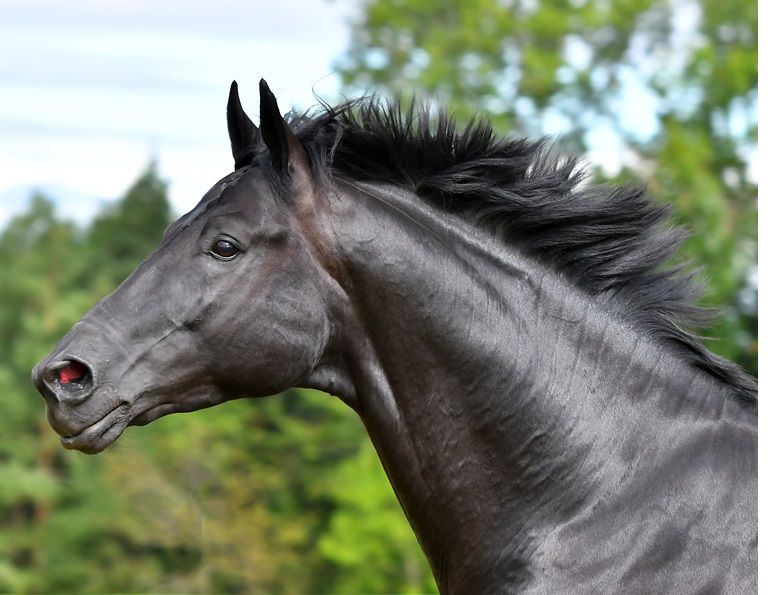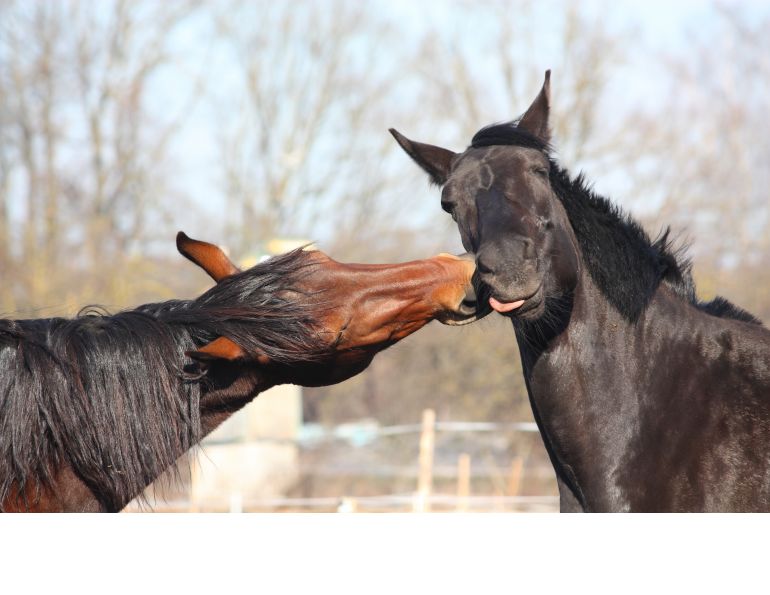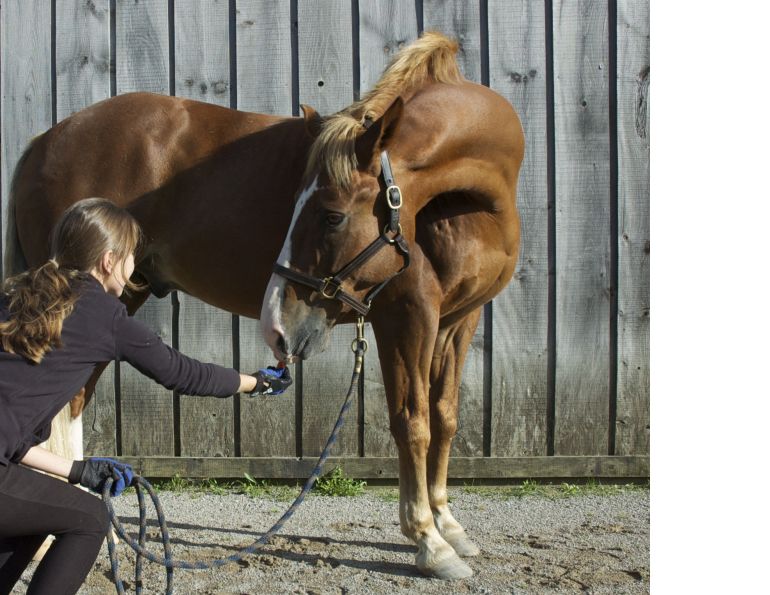By Steve Chiasson, DVM, CVMA
We are living in an exciting time for the world of equine medicine. With advances in the last few decades, horse owners have at their disposal a huge variety of both diagnostic and therapeutic options for the health care of their horses. Internal medicine, surgery, reproductive management, lameness diagnostics, dental care, neurologic care, and more can all be offered to clients either in-hospital or on-farm. Along with these advancing traditional equine health care services, we are seeing an increasing popularity of alternative therapies for many conditions. One of these fantastic therapeutic options is acupuncture.
We do, however, need to get away from the idea that other types of treatment are alternative. Many times there are several ways to treat a specific condition your horse may have. Laminitis cases may benefit from both anti-inflammatory medication and therapeutic shoeing. A chronic obstructive pulmonary disease (COPD) respiratory case may benefit from both bronchodilator medication and housing changes to control the environment. I think everyone would agree that all of these treatments may be beneficial, but we would not consider one treatment above as an alternative to the paired one. They are complimentary to each other. That is the integrated medicine approach we use with equine acupuncture.
Related: Osteoaritis - Keeping Our Aging Horses Sound
Given the length of time acupuncture has been used to treat humans and animals, we definitely can’t call it a new treatment method. Historical records show that acupuncture was first used over 2000 years ago in ancient China. This origin of Traditional Chinese medicine (TCM) is the basis of the naming system we still use in acupuncture points to this day.
It is important to note that there are two differing concepts on how acupuncture is used and how it works. The TCM concept is that energy (Qi - pronounced chee) flows through the body in a natural state of balance. Disruptions in this state of Qi occur when there are health or pain-related conditions in the body. According to TCM, placement of acupuncture needles allows the restoration of normal energy flow and a return to normal health.
Scientific or medical acupuncture is an adaptation of Chinese medicine that does not rely on the metaphors of external factors such as “wind and energy” affecting the body. Rather, medical acupuncture uses current knowledge of equine anatomy, physiology, and pathology to identify and treat specific conditions affecting your horse. Leading this approach to veterinary acupuncture is Dr. Narda Robinson, Founder and CEO of Curacore®. Along with several other types of therapy instruction, Medical Acupuncture for Veterinarians courses are available for your vet, and offer tremendous in-depth training for equine acupuncture. It should go without saying, but beware of non-veterinarian acupuncture services wanting to treat your horse. Scientific integrated medicine and acupuncture is as much about internal medicine, neurology, and anatomy as any other form of health care for your horse. Your veterinarian is best trained to assist you with the medical needs of your horse.
The theory of acupuncture is very simple. Very fine sterile needles are inserted into the body at specific locations. Those needles stimulate the nervous system and cause the body to respond. That’s it! The complex part of this treatment is knowing where those specific points are, and what the complicated responses will be. Becoming certified in veterinary acupuncture is more about studying the muscular and neurologic systems than anything else.
Acupuncture points are found along lines or “channels” on the body. Originally these paths were named after body organs, and that naming system has stuck to this day. Humans, dogs, horses, etc., all have these channels such as bladder, kidney, liver, stomach, and gall bladder (although the horse doesn’t have the latter organ). For the most part the location of these channels and points has nothing to do with the organ it’s named after, but keeping this same terminology allows for consistency when recording and discussing treatments for your horse.
The central nervous system (CNS) is made up of the brain and spinal cord. The peripheral nervous system is made up of all other nerves connecting to the CNS; for example, hitting your funny bone is stimulating your ulnar nerve of your peripheral nervous system. Placement of acupuncture needles is used to stimulate the peripheral system in this same way. The goal is for the peripheral system to “talk to” the central system and let the body regulate function itself.
Horses have two great design features for acupuncture – long spines and long legs. While you might think this just makes for more areas to get sore, it actually gives us lots of access points to treat many problems. Nerves exit the spinal vertebra at different segments and travel to locations on the body. For example, the lower neck is innervated by C4-C5-C6 spinal nerves. This same segment gives rise to nerves that travel down the forelimb. This allows us to use acupuncture points distant from the actual problem, and treat lower-right-side neck pain with needles down lower on the leg. The big advantage to this is that we can use multiple acupuncture points to treat the same area, and increase the stimulation from our treatment.
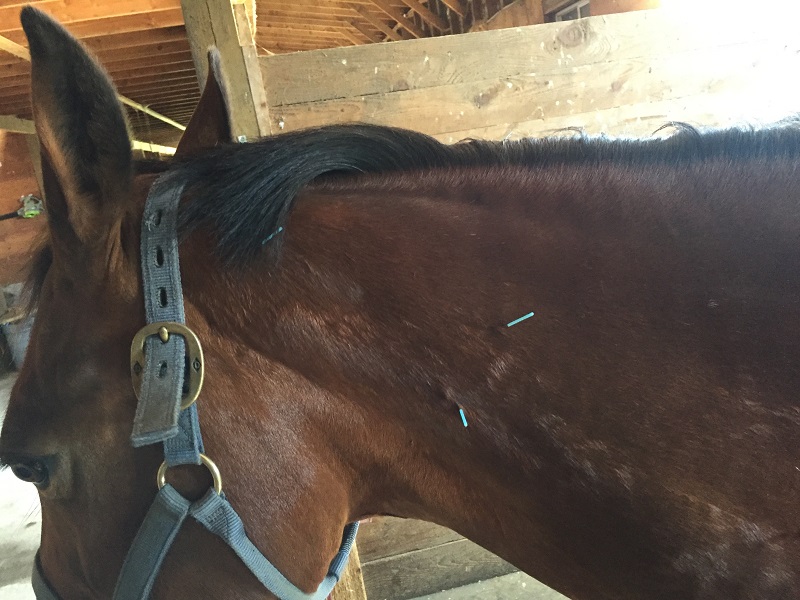
Acupuncture points in the upper neck are commonly used in the treatment of neck pain secondary to forelimb lameness. Photo courtesy of Agwest Veterinary Group Ltd.
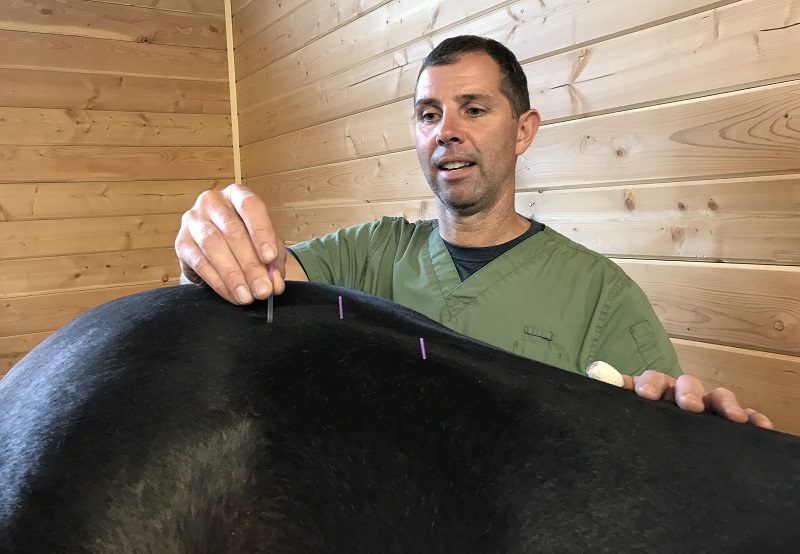
With their long spines and long legs, horses present several access points for the treatment of many problems. Photos courtesy of Agwest Veterinary Group Ltd.
Uses for Painful Conditions
Believe it or not, you have done a form of acupuncture on yourself, or acupressure at least. What’s the first thing you did when you hit your thumb with a hammer? You shook or grabbed your thumb and squeezed it. The hammer hurt, but the squeeze – not so much. This is the “Gate Control Theory of Pain” which states that “non-painful input [squeezing] closes the ‘gates’ to painful input [bad hammering], which prevents pain sensation from traveling to the central nervous system. Therefore, stimulation by non-painful input is able to suppress pain.” Another way to think about it is the first input to the “gate” at the spinal cord wins the race.
The same input happens with acupuncture needles in your horse. Mild, non-painful stimulation from the needles can override the pain input from a variety of conditions. Depending on the severity of the pain, relief may be immediate and last a variable length of time. Some cases of tense muscular pain respond very quickly and relax once the needle stimulation wins the “race to the gate.”
What’s a Typical Acupuncture Visit?
As with any procedure, the first thing your vet will do is examine your horse. There are several different types of exams depending on the presenting complaint. For acupuncture we use a myofascial palpation exam (MPE). This MPE is a very thorough hands-on palpation and manipulation of the entire body to identify areas of discomfort and dysfunction. If problems are identified that require other types of exams, such as lameness or neurological, your veterinarian will discuss those and formulate a plan with you.
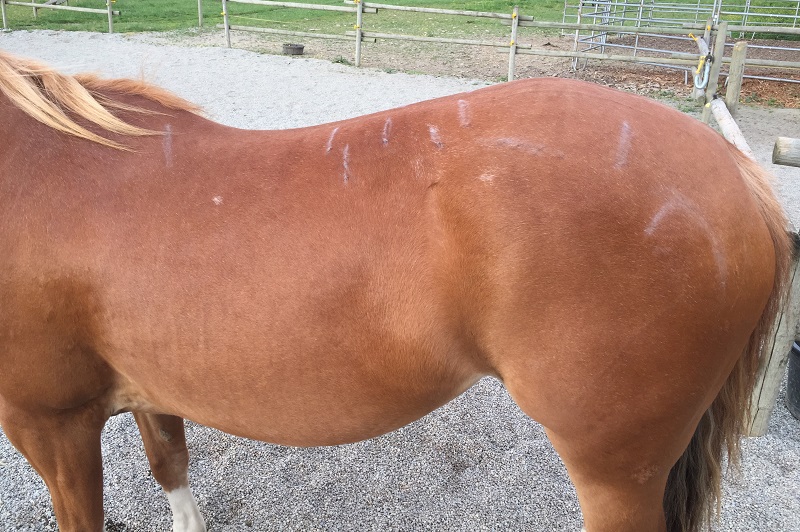
Myofascial physical exam markings are outlined in sidewalk chalk for recording. Selected points for needles are often different from just the painful areas. Photos courtesy of Agwest Veterinary Group Ltd.
Once specific areas are chosen for treatment, the acupuncture needles are placed. “Dry needling” is the basic procedure of using needles only, without any fluid injections or additional stimulation methods. Different sizes and lengths of needles are used based on their location. Small 0.16mm diameter needles are used around delicate areas like the face and coronary band of the foot, while larger 0.4mm diameter 40mm length needles may be used for treating backs and hind limbs. Since horses are very used to being handled, touched, and even vaccinated up around the shoulder/neck area, this is where I commonly place the first few needles. GallBladder21, and LargeIntestine16 are “calming points” in this area and let the horse get an idea what the needles will feel like. No sedation is required and the majority of horses quickly show the typical relaxed and yawning appearance after a few minutes. This is also commonly reported by people during acupuncture treatment.
Related: Back Pain in Sport Horses
Electrical stimulation (e-stim) can also be added to the treatment protocol. This involves placing microcurrent electrical leads to regular acupuncture needles. A controlled amount of e-stim allows for greater stimulation of the acupuncture points and the tissues between them as the current travels through the body. Amazingly, the horses seem to like this additional treatment the most. It is immediately pain relieving for tense muscle areas. Other stimulation methods can also involve injection of small amounts of fluid into the points, or heating the needles with burning moxa. Treatments can last anywhere from five to thirty minutes depending on the condition being treated and acceptance of the horse.
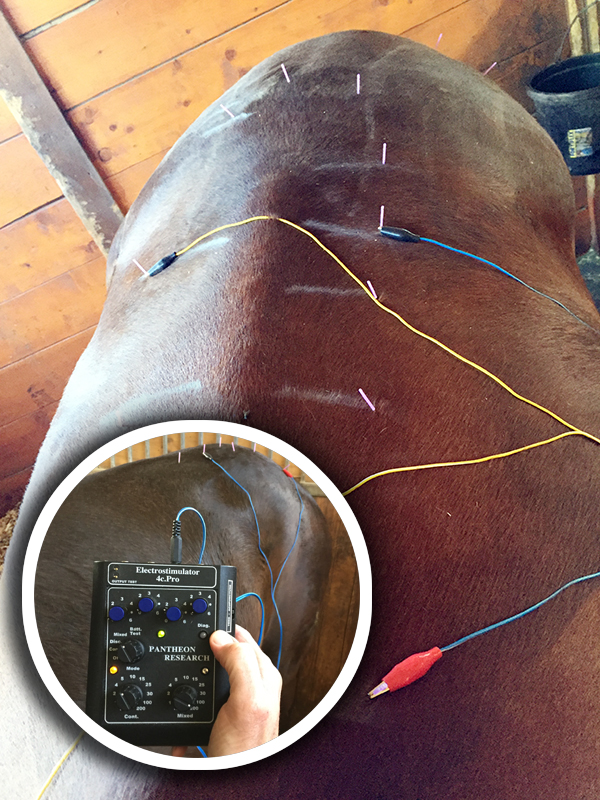
Electrical stimulation provides extra input to the acupuncture points and muscles surrounding them. E-stim may be used on specific points, or to span an area of tense muscle. Photo courtesy of Agwest Veterinary Group Ltd.
What Can Be Treated?
Acupuncture can help many conditions in the horse. By far the most common application is for the treatment of musculoskeletal pain. Sore necks, backs, and pelvic areas are prime candidates for acupuncture therapy. Tense muscle and trigger points can develop as your horse guards areas from painful movement. Full evaluation for underlying causes such as vertebral arthritis, kissing spines, and sacroiliac conditions is always important. Acupuncture does not cure laminitis or navicular disease, but it can be a valuable integrative treatment in the muscle soreness that accompanies these painful conditions.
Related: Choosing the Right Equine Therapeutic Modality
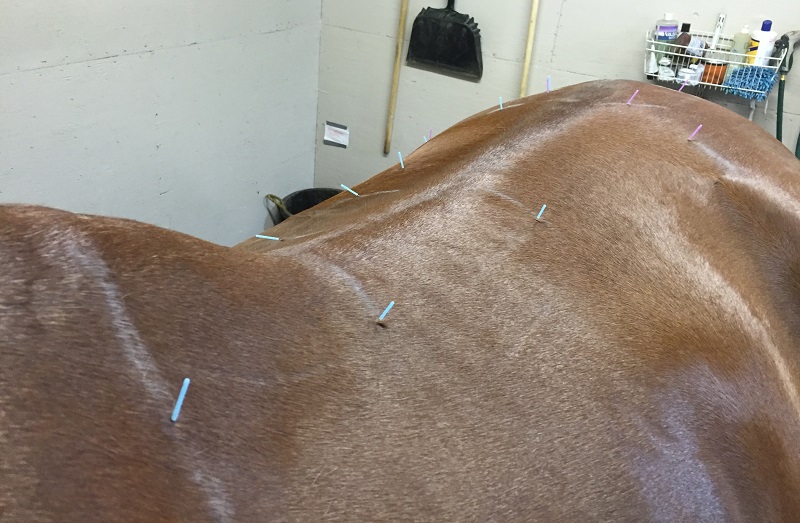
Back and pelvic pain is a good choice for your horseʼs first acupuncture treatment. Even needle-shy horses seem to enjoy the comfort a few minutes into the sessions. Photos courtesy of Agwest Veterinary Group Ltd.
One of the most rewarding acupuncture treatments is helping a horse with colic. While acupuncture does not replace lifesaving fluids or emergency surgery, it can be very effective in regulating gastrointestinal motility and digestive disturbances. The pelvic area and some specific leg points are powerful inputs to the nervous system controlling the bowel. All of my colic patients receive acupuncture as part of their routine treatment.
Related: How to Reduce the Risk of Training Related Injuries
Both respiratory and reproductive disorders can benefit from this type of therapy also. Chronic lung inflammation and congestion can be targeted with points that ease tension of respiratory muscles and have anti-inflammatory stimulating effects. Mares with urine pooling or poor vaginal conformation can be helped with stimulation of the pudendal nerve and other local nerves around the pelvis and perineum.
The acupuncture needles are placed once specific areas have been identified for treatment. Acupuncture points are often distant from the area of the actual problem, and multiple acupuncture points can be used to treat the same area. Photos courtesy of Agwest Veterinary Group Ltd.
Traumatic injuries resulting in nerve paralysis have fortunately become less common over the years. Examples of this type of injury include facial nerve paralysis (droopy eyelid, ears, and lips) and radial nerve damage around the shoulder (dropped elbow and dragging the limb forward) from running into something. These may be difficult to fully repair depending on the amount of trauma to the nerve, but I have found early treatment of these cases to be the most effective approach versus waiting until the problem is chronic.
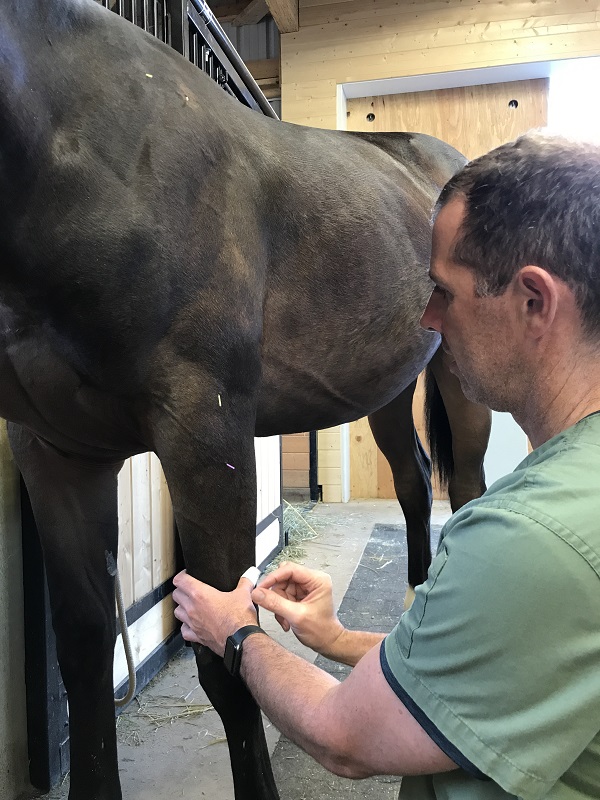
The acupuncture needles are placed once specific areas have been identified for treatment. Acupuncture points are often distant from the area of the actual problem, and multiple acupuncture points can be used to treat the same area. Photos courtesy of Agwest Veterinary Group Ltd.
Another obvious advantage of acupuncture is pre-competition treatment that requires no withdrawal time before your event. Maintenance of lingering issues is a fact of life for many show horses. Having a good working relationship with your veterinary acupuncturist is critical when using this type of therapy during your show season.
How Many Treatments Are Needed?
A common question at our clinic is about how many treatments will be needed. That’s difficult to answer prior to examination and starting some therapy. If you are considering acupuncture for your horse, a good rule of thumb is to commit to three treatments over a short time span. I usually recommend three visits spaced about one week apart. Each visit has an exam where we record our MPE findings and monitor how things are changing with the horse. Quite often acupuncture includes “owner participation,” so don’t be surprised if you are left with stretching, physiotherapy, and exercise instructions to do between visits. Owner feedback is a vital part of evaluating the treatment.
Acupuncture can be a rewarding therapy option for several conditions, and for horses of all ages and uses. I encourage you to contact your veterinarian and discuss the benefits your horse might see from this integrated treatment approach.
Related: Equine Chiropractic
Related: The Wild West: Navigating Canada's Unregulated Horse Industry
Main photo courtesy of Agwest Veterinary Group Ltd.



